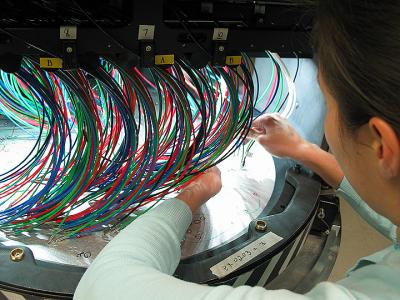NMSU's Apache Point Observatory is filmed for BBC special

The main stars? The SDSS technicians who spend hours every day, 365 days a year, aligning fiber optic cables into holes in "plug plates" that route light from a telescope focal plane to spectrographs. Each hole is a two-dimensional representation of a galaxy. There are 1,000 holes per plate and nine plates observed each night.
"When the film crew came out and saw the plug plates, they immediately wanted to focus on that," said Klaene. "If you look at the final product of the film, they had other facts and information for their story and the plates stood out as something different from what other researchers provided them."
The BBC show, Horizon, also spent time in Cloudcroft and the surrounding area filming for their special, "How big is the universe."
For the show, Horizon followed cosmologists who have taken on the task of mapping everything in existence, and coming to the very real conclusion that the universe continues to grow and may actually have no end. For its part, APO is working to create a three-dimensional map of the universe as part of SDSS-III.
The video can be viewed at http://www.youtube.com/watch?v=Dne6rnITayI.
For the show, the film crew interviewed Francis Cope, Tracey Naugle and Kristina Huehnerhoff about their experiences as "pluggers."
In the video, Cope, who has mapped nearly a quarter of a million stellar objects, said she finds the experience therapeutic, while Christina, a freelance writer, called her work at the observatory her zen time. On film, Naugle said it is neat to be a part of discovering new galaxies.
Along with the technicians, the BBC show interviewed David Schlegal, a cosmologist at the Lawrence Berkeley National Lab who joined SDSS in 1998. At that time, only 30,000 galaxies in our universe had been mapped. Schlegal took on the ambitious task of mapping a million of the brightest galaxies in the sky.
Gretchen Van Doren, NMSU's astronomy program manager, served as the observatory's media liaison to the film crew.
Klaene said he is impressed by the footage and said he liked how the show took a new angle to the research by comparing the mapping of the universe to an everyday roadmap. He said he was also pleased that the film crew incorporated a sense of community into the final product.
"That helps make our presence know a little bit more in the community," Klaene said. "We're a 30-minute drive from Cloudcroft. The residents their do not necessarily make that connection with us."
It also doesn't hurt that the video helps keep the work at Apache Point fresh in people's minds.
"To have this kind of publicity that showcases what we are doing here with our science and research on a program like this always works in our favor," he said.
This is the second time this year that Apache Point Observatory has been visited by a film crew. Earlier this year, a crew from Japan was on location filming for a television special on dark matter and dark energy. The special was filmed in Japanese.
"They sent us a DVD copy of the special," Klaene said. "We have all this footage and not a one of us as a clue what they are saying!"


